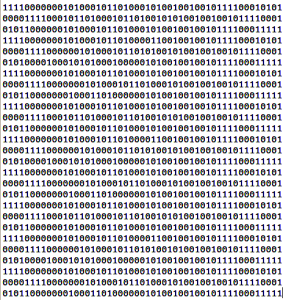
The binary number system is an important system in digital electronics. Because in digital electronics we are using only 1’s and 0’s. But what does this mean?
That’s something I was wondering about for a long time. I thought it was something really difficult and abstract. But when I one day asked my dad about it, it really surprised me how easy it was!
It turns out that a “1” is just a wire with voltage and a “0” is a wire without a voltage. It’s that simple!
The reason for this system is to make the electronics easier. A circuit which only needs to check if there is a voltage or not on the wire is really easy. Just have a look at how the transistor works and you’ll get an idea.
In order to make any sense out of the ones and zeroes, we use a binary number system.
Making Sense of 10011101
We call the normal number system the “decimal system”. To distinguish between the decimal system and the binary system, we use a subscript of either 2 or 10.
Example:
![]() (Binary number)
(Binary number)

10 Simple Steps to Learn Electronics
Electronics is easy when you know what to focus on and what to ignore. Learn what "the basics" really is and how to learn it fast.
equals
![]() (Decimal number)
(Decimal number)
How To Convert From The Binary Number System To Decimal?
The binary number system works like this:
- The value of the last position on the right side is 1.
- The next position, to the left of this is 2.
- The next to the left of this is 4.
- The next to the left of this is 8.
- And it keeps doubling for each position to the left.
Now to find the decimal value of a binary number, you add all the values that has a “1” in their position.
| Value | 8 | 4 | 2 | 1 |
| Binary Number | 1 | 0 | 1 | 1 |
So ![]()
is ![]()
| Value | 4 | 2 | 1 |
| Binary Number | 1 | 0 | 1 |
![]() is
is ![]()
How To Convert Decimal To Binary Numbers
Converting from the decimal system to the binary system is a bit more complicated, but still not too hard.
Let’s say we want to convert 118 to the binary number system.
Divide the number by two and put the remainder on the right. Do this until we get 0:
![]() Remainder: 0
Remainder: 0![]() Remainder: 1
Remainder: 1![]() Remainder: 1
Remainder: 1![]() Remainder: 0
Remainder: 0![]() Remainder: 1
Remainder: 1![]() Remainder: 1
Remainder: 1![]() Remainder: 1
Remainder: 1
Then we take the remainders and organize into a binary number with the last remainder on the left side.
So![]()
More Info
Wikihow also has a really good article about decimal to binary conversion.
Check out logic gates to see how this is used in a circuit on a very low-level.
Return from Binary Number System to Electronic Schematics
More Digital Electronics Tutorials

Get Our Basic Electronic Components Guide
Learn how the basic electronic components work so that circuit diagrams will start making sense to you.
